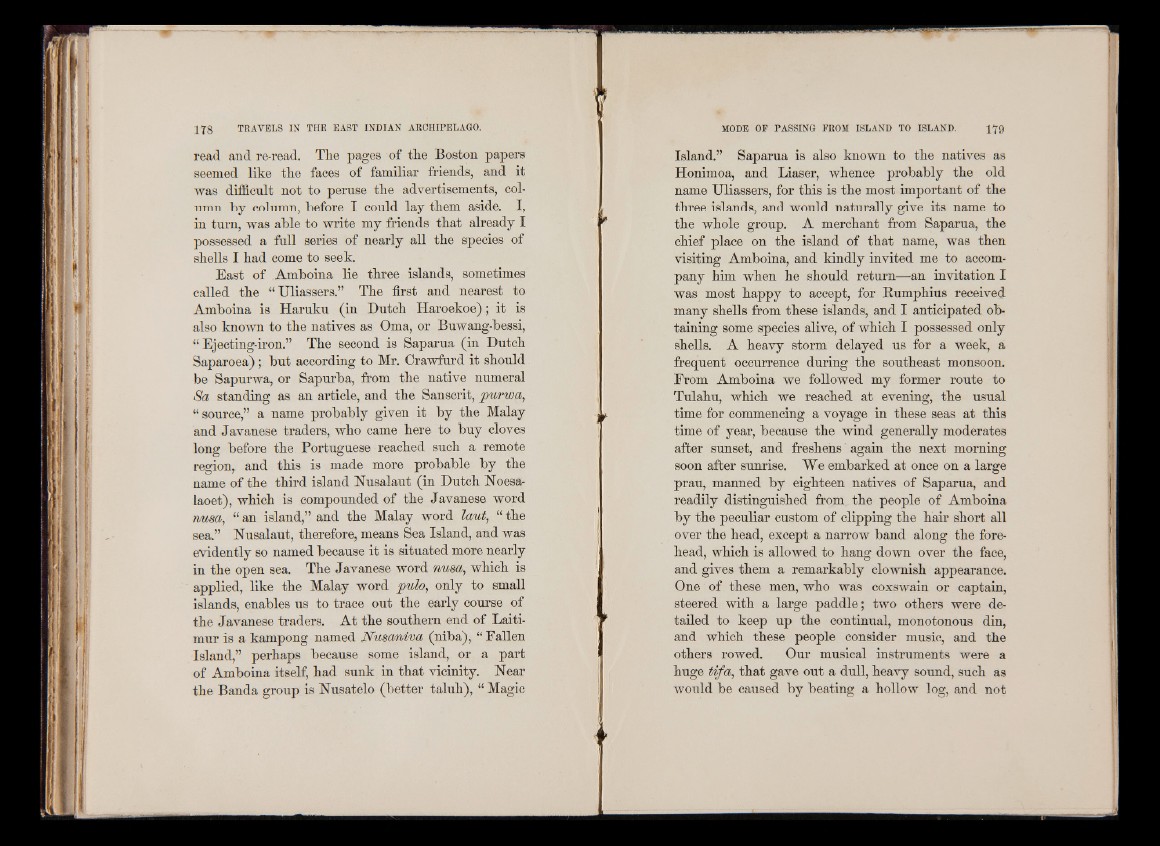
read and re-read. The pages of the Boston papers
seemed like the faces of familiar friends, and it
was difficult not to peruse the advertisements, column
by column, before I could lay them aside. I,
in turn, was able to write my friends that already I
possessed a full series of nearly all the species of
shells I had come to seek.
East of Amboina lie three islands, sometimes
called the “ Uliassers.” The first and nearest to
Amboina is Haruku (in Dutch Haroekoe); it is
also known to the natives as Oma, or Buwang-bessi,
“ Ejecting-iron.” The second is Saparua (in Dutch
Saparoea); but according to Mr. Crawfurd it should
be Sapurwa, or Sapurba, from the native numeral
Sa standing as an article, and the Sanscrit, pwrwa,
“ source,” a name probably given it by the Malay
and Javanese traders, who came here to buy cloves
long before the Portuguese reached such a remote
region, and this is made more probable by the
name of the third island JSTusalaut (in Dutch ISToesa-
laoet), which is compounded of the Javanese word
nusa, “ an island,” and the Malay word laut, “ the
sea.” Nusalaut, therefore, means Sea Island, and was
evidently so named because it is situated more nearly
in the open sea. The Javanese word nusa, which is
applied, like the Malay word pulo, only to small
islands, enables us to trace out the early course of
the Javanese traders. At the southern end of Laiti-
mur is a kampong named Nusanwa (niba), “ Fallen
Island,” perhaps because some island, or a part
of Amboina itself, had sunk in that vicinity. Near
the Banda group is Nusatelo (better taluh), | Magic
Island.” Saparua is also known to the natives as
Honimoa, and Liaser, whence probably the old
name Uliassers, for this is the most important of the
three islands, and would naturally give its name to
the whole group. A merchant from Saparua, the
chief place on the island of that name, was then
visiting Amboina, and kindly invited me to accompany
him when he should return—an invitation I
was most happy to accept, for Bumphius received
many shells from these islands, and I anticipated obtaining
some species alive, of which I possessed only
shells. A heavy storm delayed us for a week, a
frequent occurrence during the southeast monsoon.
From Amboina we followed my former route to
Tulahu, which we reached at evening, the usual
time for commencing a voyage in these seas at this
time of year, because the wind generally moderates
after sunset, and freshens' again the next morning
soon after sunrise. We embarked at once on a large
prau, manned by eighteen natives of Saparua, and
readily distinguished from the people of Amboina
by the peculiar custom of clipping the hair short all
over the head, except a narrow band along the forehead,
which is allowed to hang down over the face,
and gives them a remarkably clownish appearance.
One of these men, who was coxswain or captain,
steered with a large paddle; two others were detailed
to keep up the continual, monotonous din,
and which these people consider music, and the
others rowed. Our musical instruments were a
huge Ufa, that gave out a dull, heavy sound, such as
would be caused by beating a hollow log, and not